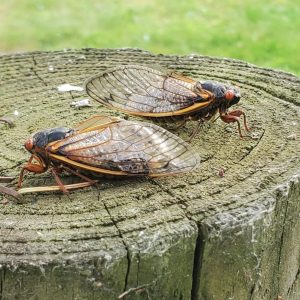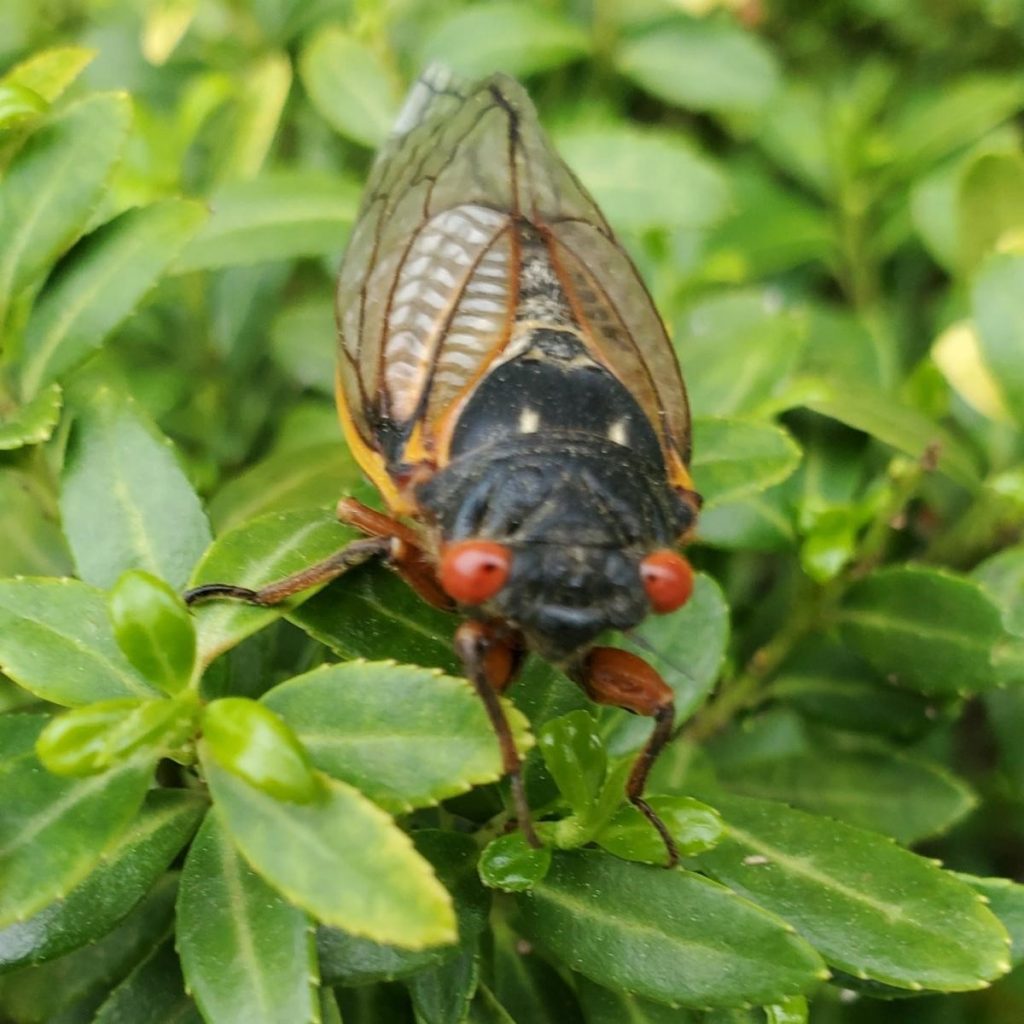Karl Gardner noticed the first signs of invasion in April.
Under a matted carpet of grass, he found the holes; each no bigger than a dime and some capped with mud. Gardner soon discovered that his entire yard was freckled with these hollows, finding several openings per square foot in some places.
Since purchasing this property 51 years ago, Gardner had encountered these holes 2 other times, most recently in 2004, and understood immediately what they signaled. The Brood X cicadas had returned.
By now, Brood X (pronounced Brood Ten) has become a household name – but what makes this recent surge in cicadas so notorious?
Let’s start with the basics.
Cicadas are insects belonging to the order Hemiptera, a diverse taxonomic group of “true bugs” usually equipped with 2 pairs of wings and a sharply pointed mouth designed for piercing and sucking. Hemipterans are the vampires of the bug world, mostly imbibing plant sap but other macabre members of this order have developed a taste for mammalian blood. Don’t worry, cicadas are sap suckers! We humans are in the clear.
All cicadas hatch from eggs embedded in tree branches, securely inserted there by their mother, and then drop to the ground where they bury into the soil. Underground, the young cicadas, called nymphs, stay busy tunneling about and feeding on plant roots. When the timing is right, anywhere from 2 to 17 years later, cicada nymphs emerge from the ground. Back on surface, they shed their exoskeletons and assume their noisy, winged adult form.
Adult life is fleeting; just long enough to hold one raucous party, mate, and, in the case of females, lay the next generation of eggs.
On Gardner’s property, the festivities began in late May; the first members of Brood X lifting their anthem to the air. High up in the trees, the males belted their droning ballad, flexing a specialized, drum-like organ in their abdomens while females clicked back in amorous acknowledgement.
Two weeks after the concert began, Gardner noticed new mothers laying their eggs; first in the bowing branches of his weeping willow then followed by the eastern red bud and a seedling peach tree. In six or so weeks, these eggs will hatch and young cicada nymphs, stark white and ant-sized, will emerge and fall to the ground in pursuit of subterranean shelter.
There are nearly 3,400 species of cicadas worldwide who follow this same, general life cycle. But of those only seven are known as periodical cicadas, so named for their mysterious ability to synchronize their life cycles and emerge simultaneously in overwhelming swarms every 13 or 17 years. Four species follow the 13-year cycle and three follow the 17-year cycle.
These periodical cicadas are found only in the central and eastern United States.

Whereas most cicadas simply emerge whenever they reach their mature size and weight, periodical cicadas synchronize their schedules with one another, emerging after a fixed number of years regardless of when they reach full size. To get the timing right, periodical cicadas are thought to count plant cycles, monitoring seasonal fluctuations in the tree sap they feed on to keep time.
Once the plants have completed 13 or 17 cycles, the cicada nymphs wait for the soil to warm up to about 64 degrees Fahrenheit and then make their big appearance en masse.
Periodical cicadas are organized into 15 geographically defined broods, each identified by a Roman numeral. Broods can be a mixed group of different species, but they always share two things: first, all members of a given brood follow the same life cycle length of either 13 or 17 years and second, all cicadas in a brood emerge in the same year.
Some broods are confined to small regions, like Brood VII, which is only found in upstate New York. Brood X, also known as the Great Eastern Brood, is the largest brood of 17-year cicadas, renowned for its expansive range which covers 14 states stretching from Tennessee to New York.
We’ve tracked the clockwork schedule of periodical cicadas in wonderment for centuries. The pilgrims of Plymouth Rock apparently mistook periodical cicadas for locusts when they arrived in North America in the 1600s and Thomas Jefferson supposedly encountered Brood II just a year before penning the Declaration of Independence.
The grand emergence of our periodical cicadas is a treasured tradition older than the nation itself, and yet this enduring phenomenon remains steeped in mystery.
For example, we still don’t fully understand why these seven species evolved to have such long life spans, specifically following 13- and 17-year intervals. But the answer may have something to do with pressure from predators.
Whereas annual cicadas are known for their quick, evasive maneuvers, periodical cicadas are sluggish, less flighty, and easy to apprehend: a predator’s dream quarry. Instead, periodical cicadas find safety in numbers.
By synchronizing their life cycles, broods of periodical cicadas emerge in mind-boggling densities, as many as 1.5 million packed into a single acre! In these immense swarms, predators from birds to spiders to snakes can eat their fill without ever putting a dent in the population. This is known as the predator satiation theory, where the immense density of one animal completely overwhelms their predators’ ability to consume them.
At the same time, long, prime-numbered life cycles are difficult for predators to track. Consider the annual salmon run, where great numbers of salmon return to their natal, freshwater streams to spawn the next generation. Because this ritual repeats itself each year, local predators have timed their own annual sojourn to these waters to coincide with the salmon’s migration.
When the buffet only opens every 13 or 17 years though, it’s a lot harder to plan ahead.
But, returning to our original question, why 13- and 17-year life cycles? Why not 11 or 19 years? These too are long, prime-numbered time frames. What’s so special about the 13- and 17-year intervals adopted by periodical cicadas?
One newer theory suggests predator avoidance (or perhaps manipulation?) could be the cicada’s goal.
Researchers Walter Koenig and Andrew Liebhold used the population sizes and metabolisms of 15 insectivorous bird species to estimate the total predation pressure placed on emerging periodical cicadas over a 45-year period. Incredibly, on the years that periodical cicadas emerged, avian predation pressure was markedly lower!
In the case of cicadas following the 17-year life cycle, predation pressure actually increased steadily following the big emergence. But then after year 12, this predation pressure dropped, reaching its lowest point at – yup, you guessed it – year 17.
Hypothetically, birds could have been avoiding the areas overwhelmed by cicadas or perhaps birds were simply harder to find amid the cacophony and chaos, leading researchers to report deflated numbers. But trends in bird population size both within and outside of cicada brood ranges were found to follow the same pattern, indicating a true decline in predation pressure.
Koenig and Liebhold instead suggest that predator satiation, besides being an important defensive outcome of the cicada’s synchronized emergence, may also play a role in determining the unique 13- and 17-year life cycles of periodical cicadas! These overwhelming feasts may instigate a long-term response in bird populations, resulting in depressed predation pressure at 13- and 17-year intervals, ultimately benefitting the cicadas, who time their synchronized emergence to coincide with these lulls.
In other words, cicadas may have found a way to manipulate future bird populations to be lower during the next generation’s emergence over a decade later! Talk about foresight!

Despite their apparent influence over predatory threats, cicadas now face a new suite of challenges that they may not be as prepared to overcome. Two broods have already gone extinct and Brood X’s range may be shrinking.
As far back as 1902, Brood X cicadas have been recorded on Long Island, New York. But in 2004, Long Island got stood up by Brood X; its mass emergence significantly suppressed both on Long Island and in several nearby towns.
Changing climate and land use patterns are suspected as possible culprits.
Periodical cicadas take their cues from the environment, keeping time using seasonal plant patterns and coordinating their emergence with soil temperatures. But as climatic patterns change, so too may the environmental time pieces periodical cicadas rely upon to synchronize their life cycles.
For periodical cicada broods to persist, they must emerge at a sufficient density to satiate the local predators. Getting the timing wrong and emerging without reaching a critical quorum could spell disaster.
Furthermore, as cicada nymphs bide their time underground, a lot can change on the surface above them.
When forests are felled, cicadas not only lose their primary food source, but they also lose their concert venues and nurseries. The cicada life cycle relies on the existence of trees and cannot be completed if forests disappear. Furthermore, the houses and pavement that replace forests create an impenetrable barrier that can quite literally trap naïve cicada nymphs underground.
According to Gene Kritsky, of Mount St. Joseph University, habitat loss is the greatest threat facing periodical cicadas. As early as 1919, the USDA predicted that deforestation would spell the end for Brood X.
Thankfully, efforts are underway to better understand and protect this wild spectacle. For decades, the public has helped researchers track the nation’s periodical cicadas by reporting their sightings; first using postcards, later over the phone, and then via e-mail.
Today, it’s easier than ever to join this community science effort and help researchers map the periodical cicada emergences! Want to get involved? Or maybe you’re curious to review the scope of Brood X’s 2021 emergence?
Kritsky and his colleagues have developed a new crowdsourcing app called Cicada Safari, which allows anyone to submit pictures and videos of any cicada they encounter. As people share their entries, sightings will automatically populate a map to visualize the Brood X emergence in real time!
As June comes to a close and the cicadas’ sensual serenade relents, let us send Brood X off not with a “farewell” but with an “until next time” – for unless we make the promise to keep this landscape safe, there may not be one.




